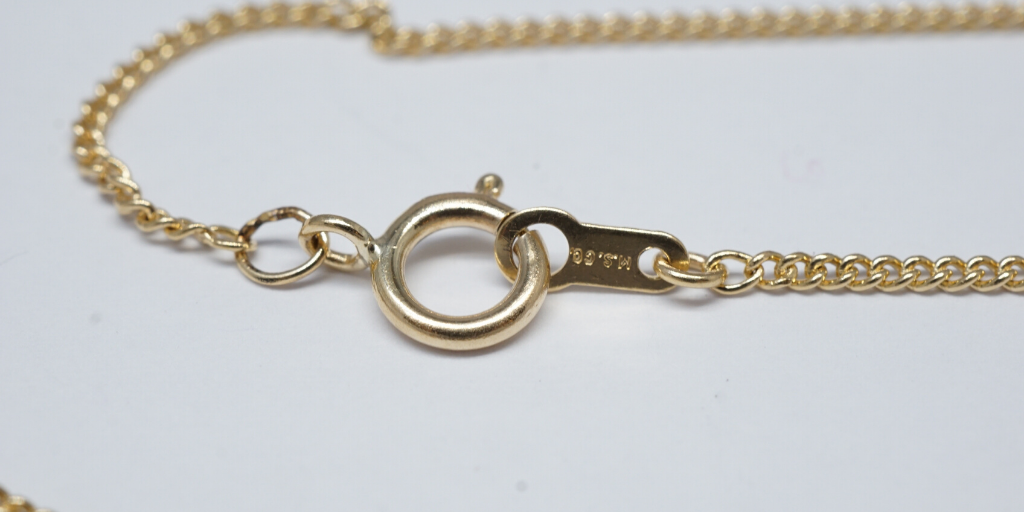How To Keep Your Clasps In Good Condition
Written by Annabelle
December 10, 2019

It’s such a small part of your jewelry, but it plays an essential role in keeping your jewelry wearable…what is it? A clasp is the little mechanism that allows you to securely put your jewelry on, and take it off. Over time, a clasp can wear out or break from use. Read on to learn more about jewelry clasp maintenance.
Know Your Clasp
In order to properly go about your jewelry clasp maintenance, you need to understand what kind of clasp you have. Like jewelry, they can come in many forms; lobster, spring ring, toggle, and box are some of the most popular clasp types. Each clasp type has its own unique design and structure, as well as its own pros and cons.
Some clasp types are better for certain people. Many of our customers often come to us asking for a clasp replacement because they can’t open the original clasp. Whether it’s due to the design of the piece, or arthritis in their fingers, we usually default to getting them a barrel clasp, which only needs to be twisted apart to open, or a larger clasp in the same design for their convenience. If you have a hard time opening your piece, or you’re rough with your jewelry, then you should also consider switching your current clasp out for a different design.
The Pros and Cons of Jewelry Clasp Types
Box Clasps
Box clasps are very secure clasps commonly found on tennis bracelets and high-end necklaces. These clasps are incredibly elaborate; first, a flat “tongue” slots into an empty box to close the clasp. Then figure-eight safety locks on the sides of the clasp catch onto little balls soldered to the sides for additional security. As a result, it’s difficult to lose a piece that has a box clasp thanks to all the mechanisms that hold the clasp in place.
On the other hand, the elaborate design of the box clasp can cause frustration. Sometimes the box clasp loosens over time, causing the tongue to easily slip out of the slot. Conversely, it can also be too tight, requiring the user to strongly pull at the clasp at risk of damaging the piece. The figure eight safety locks also suffer from the same issue, and can bend easily as they are made from soft metal wire.

A box clasp open and closed.
Lobster clasps
Standard clasps that use a simple latch mechanism to open and close around a matching jump ring. They’re generally inexpensive to repair and are easy to work with.
However, small lobster clasps can be difficult to open since the lever is so small, and if the little portion that opens and closes snaps off, the clasp is essentially useless.

A lobster clasp on a thin gold chain.
Spring rings
The cheapest standard clasp, spring ring clasps function similarly to the lobster clasp. They’re extremely affordable and are very lightweight in comparison to other clasps. They also blend in with the design of the jewelry due to their thin structure, which is similar to a spring ring.
Spring rings are usually hollow, and are the flimsiest type of clasp as they can be dented and crushed easily. It’s often easier to replace these clasps than repair them.

A broken jump ring on a serpentine necklace. Note that the lever is gone.
Toggle clasps
Consisting of a bar that goes through a large loop, toggle clasps are often intentionally incorporated into a design for their aesthetic. They’re great for people who have a hard time putting clasps on, as there is no need to pull or press on anything small. However, because of their easy construction and reliance on the friction between the bar and the loop, toggle clasps are very prone to loosening and falling off easily. Repair is usually unnecessary for toggle clasps; most customers simply need replacement if one component goes missing.

A 24k gold toggle clasp.
Maintaining Your Jewelry Clasps
Now that you have some background on different clasps and their designs, here’s a general list of ways to keep your clasps in good condition.
- Avoid crushing your jewelry. Spring rings can be easily smashed if something heavy is placed on top, as they are made out of a hollow tube of metal.
- Avoid tugging too hard on your clasps to open them. If you’re experiencing issues with your box clasp, for instance, take it to a jeweler who can readjust the fit of the clasp. Pulling too hard on the clasp to open it can not only damage the clasp, but also the surrounding portions of the jewelry.
- Avoid leaving your jewelry in humid locations. Certain kinds of metals are prone to rust and oxidation, especially metals in costume jewelry. Clasps rely on their internal workings to function, and the humidity will cause rust to form, making your clasp unusable.
- Avoid getting lotion or soap into your clasp. Residue can build over time, and clog up your clasps. Aside from forming an unattractive film on the interior of your clasp, it’ll also affect the clasp’s mechanism.
Keeping these jewelry clasp maintenance tips in mind will help you extend the longevity of your clasp, and your jewelry! If you have a clasp you need to repair or replace, check out our clasp service here.


